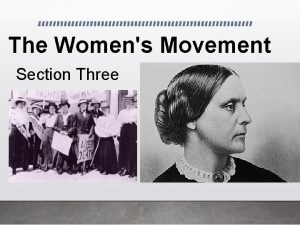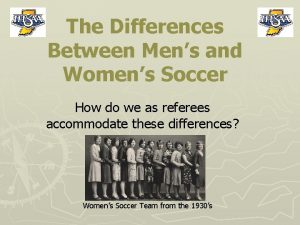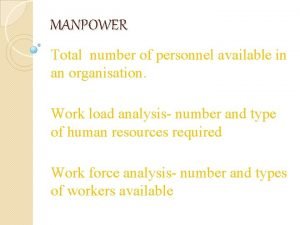Is Womens Work Devalued Evidence from Unique Personnel












































- Slides: 44

Is Women’s Work Devalued? Evidence from Unique Personnel Data of a Russian Firm during Transition (1990 -2006) WORK IN PROGRESS! Thomas Dohmen, University of Bonn and IZA Karolina Goraus-Tanska, University of Warsaw Hartmut Lehmann, University of Bologna, NRU HSE and IZA 21 November 2019 Center for Institutional Studies Research Seminar Higher School of Economics Moscow

Is Women’s Work Devalued? Motivation Devaluation of females’ work § While gender gaps in wages in most regions of the world were narrowing over time, they continue to persist in part due to how female’s work is valued. § Differences between occupations and industries in which men and women work account for more than half of the gender gap (Blau and Kahn, 2016). § “Traditionally female” occupations offer lower remunerations to its workers than male dominated occupations that require similar level of skill and education – especially pronounced when local labor market is more segmented (Cohen and Huffman, 2003). § When occupations are becoming more feminized the pay is relatively declining (Levanon et al. , 2009).

Is Women’s Work Devalued? Results Changes in occupational structure and wages Devaluation vs. queuing view § Queuing view: occupations’ wage level affect their gender composition (Reskin and Roos, 1990) § Everyone prefers to work in better paid occupations, but employers prefer men § Discrimination occurs in the process of hiring or placement § As a result, women cluster in occupations offering relatively lower wage for its skills’ requirements § Devaluation view: gender composition affects occupations’ pay (England, 1992; Sorensen, 1994; Steinberg, 2001) § Decisions of employers’ about the relative pay in more feminized occupations are affected by gender bias (Levanon et al. , 2009) § Employers value less work done in more feminized occupations and consequently set lower wages. § It might be that both processes take place

Is Women’s Work Devalued? Motivation Changing situation of women over transition § Before transition, the levels of gender wage gaps were at similar level as in Western Europe countries, and female employment rates were among the highest in the world (Brainerd, 2000). § The evolution of the GWG was heterogenous between countries, e. g. increase in Russia and Ukraine (Brainerd, 2000, Newell and Reilly, 1996, Reilly, 1999, Ganguli and Terrell, 2005), and decrease in central Europe countries or East Germany (Hunt, 2002, Vodopivec and Orazem, 2000, Andren and Andren, 2015, Grajek, 2003, Pollert, 2003). § At the same time, employment rates of women were falling (Newell and Reilly, 2001, Homlong and Springler, 2006)

Is Women’s Work Devalued? Motivation Adverse effects of transition on women § Growing poverty and inequality were largely feminized (Pollert, 2003). § Revival of traditional gender roles (Pollert , 2003, Rodovic-Markovic, 2011). § Budget restrictions affecting healthcare and education benefits, as well as rights to maternity leave and childcare (Rodovic-Markovic, 2011; Pollert, 2003; Ferge Z. , 1997, Ingham and Ingham, 2002). § Overall, transition countries lost their top positions in e. g. Gender -related Development Index or Relative Status of Women index (Pollert, 2003).

Is Women’s Work Devalued? Motivation Advantages of personnel data analysis I § Gender earnings differentials may be related to the productivity differences and sorting of women and men into different firms (Kremer, 1993; Carrington and Troske, 1998) § Analyzing an internal labor market allows to verify whether gender gaps remain within very homogeneous groups of workers (Kunze, 2008) § Studying career paths of workers may shed light on reasons underlying the emergence and the evolution of the gender wage gap over the course of transition

Is Women’s Work Devalued? Motivation Advantages of personnel data analysis II § This analysis might also tell us something about labor market adjustment during transition in general (e. g. , how rapidly this adjustment occurs or whethere is a lot of inertia from Soviet times) § Longitudinal character of the data might allow to establish causality in the relation between occupations’ proportion of women and its wage level (devaluation vs. queuing) The set-up of our research is a quasi-natural experiment: we observe evolution from the communist wage structure, not determined by market forces, into a wage structure that is determined by market forces.

Is Women’s Work Devalued? Motivation Previous work on gender earnings gap in the same Russian firm but with more limited data (Dohmen, Lehmann and Zaiceva 2008) Data limitations: § Only data from 1997 to 2002 § Wages are monthly wages averaged over the year § Hours worked not available – only full-time vs. part-time status § Career paths cannot be inferred from data

Is Women’s Work Devalued? Motivation Main results from previous analysis § A large fall of earnings gap from 38% in 1997 to 18% in 2002. § This convergence is driven by an increase in rewards for women – in particular at the lower end of the distribution. § These differentials at the mean and across distribution are largely unexplained by observable characteristics. § For 2002, we find that differentials for production workers are mainly explained by job assignments: women are assigned to low job categories.

Is Women’s Work Devalued? Motivation This paper: Contribution I Very rich and long panel data set, giving us: § possibility to construct real hourly wages § possibility to analyze evolution of wage gap over entire transition with monthly wage data for 17 years § very detailed information on position of workers for every month Possibility to analyze career paths within the firm and the evolution of wages for different types of workers

Is Women’s Work Devalued? Motivation This paper: Contribution II We evaluate the changes in relative wages of women and men going through a three step procedure: § We apply Oaxaca (1973) and Blinder (1973) decomposition to estimate the adjusted gender wage gap over the 1990 -2006 period → we find that GWG increased since transition § We use second-order decomposition (Juhn et al. 1991) to verify whether increasing GWG was due to increasing withinoccupation gender wage differences, or rather more feminized occupations were receiving relatively lower pay over time → we find that the latter plays a major role § We aim to disentangle factors standing behind this evolution → work in progress

Is Women’s Work Devalued? Personnel data – information about the firm § Data covers 17 years (1990 -2006) § Personnel data of a large firm operating in the sector machine building and metal works (MBMW) that produces mainly equipment for oil and gas production § Firm was established in 1950 s and privatized in 1992 § Firm is located in central Russia (not in Moscow, though) § Firm successfully managed transformation from military production to production of civilian goods – hence belongs to that minority of firms in the MBMW sector that managed transformation well.

Is Women’s Work Devalued? Personnel data – information about the firm § Since 1996 firm has a steady stream of orders and a stable demand for production workers (only very briefly interrupted by the financial crisis of 1998) § Employment and wage policies determined exclusively by CEO and a few top managers (large enough block of voting shares to determine all decision making in the firm) § Wage arrears play a role in the years 1992 to 1995

Is Women’s Work Devalued? Personnel data – information about the workers § Monthly data for the years 1990 -2006 § Average employment over the period: around 3700 workers § Data covers all workers apart from top managers § Many workers observed for more than a decade § Exact date of arrival in the firm and exact date of separation (if applicable) can be determined

Is Women’s Work Devalued? Personnel data – information about the workers § Demographic information: gender, date of birth, marital status, education level, and children § Occupational categories: § managers, § accountants, § technicians (or “engineers”), § production workers § service staff § Further categorization of production workers: § primary production workers of 8 levels and § auxiliary production workers of 6 levels § Complete information on career path within the firm § Monthly wages

Is Women’s Work Devalued? Personnel data Firm was downsizing for most of the period Year 1990 1992 1994 1996 1998 2000 2002 2004 2006 Mean Number of workers 4850 4205 3535 3328 3376 3241 3330 3485 3903 3709 Share women 0. 34 0. 33 0. 34 0. 35 0. 34 0. 33 0. 34

Is Women’s Work Devalued? Personnel data Insights from descriptive statistics: 1990 vs 2006 § The share of older workers increased in line with demographic changes in the country - GWG higher for older workers § Educational structure is the same in 1990 and 2006 (also same share of women within each category) - GWG in 1990 higher among the lower educated, while in 2006 it is highest among those with high education § Average tenure lower in 2006 than in 1990, and gender gap in tenure emerged over time § GWG among workers without children remained the same, but strongly increased among persons with children § Shares of workers in different occupations was stable over time, and (positive) GWG emerged only for managers

Is Women’s Work Devalued? Personnel data Employment structure and wage gaps at beginning and end of transition

Is Women’s Work Devalued? Results Gender wage gap evolution Gender wage gap over time

Is Women’s Work Devalued? Results Gender wage gap evolution Insights from GWG evolution § GWG almost non-existent at the beginning of the analysed period § Very strong increase since 1996 and GWG peaking in the crisis year of 1998, than strong decrease to around 16% in 2006 § End-of-year bonus payments had decreasing effects on GWG § Change of GWG in the firm is in line with evolutions for the Russian workforce overall, e. g. Kazakova (2007) showed the gap decreased from 35% in 1996 to 16% in 2002; similar change also in Atencio and Posadas (2015)

Is Women’s Work Devalued? Results Gender wage gap evolution GWG in Russia (Atencio, Posadas, 2015)

Is Women’s Work Devalued? Results Gender wage gap evolution Adjusted gap - after controlling for demographic characteristics and all available covariates

Is Women’s Work Devalued? Results Gender wage gap evolution Insights from GWG decompositions § Demographic characteristics do not explain observed GWG § Controlling for occupation types and levels makes adjusted GWG (AGWG) vanish or turn negative, except for the crisis period around 1996 -1998 § Decompositions across the entire distribution revealed that in 1990 AGWG was highest for those with lowest earnings, while in 2006 it is growing along the wage disitribution with highest AGWG for top earners § Stark increase in the explained component of the GWG suggests that eithere was more occupational seggregation or maledominated occupations experienced larger increases in wages

Is Women’s Work Devalued? Results Gender wage gap evolution Decomposition of GWG evolution (Juhn et al. 1991)

Is Women’s Work Devalued? Results Gender wage gap evolution Decomposition of GWG evolution (Juhn et al. 1991)

Is Women’s Work Devalued? Results Gender wage gap evolution Decomposition of differences in the raw gender wage gap between 1990 and subsequent years → points to devaluation rather than sorting

Is Women’s Work Devalued? Results Gender wage gap evolution Decomposition of differences in GWG between same workers in the given year and five years later → points to devaluation in early period and a reversal later

Is Women’s Work Devalued? Results Changes in occupational structure and wages Movements within the firm and in- and out- of the firm in selected sub-periods

Is Women’s Work Devalued? Results Changes in occupational structure and wages Occupational structure of the firm and wages in January 1990

Is Women’s Work Devalued? Results Changes in occupational structure and wages Occupational structure of the firm and wages in January 2006

Is Women’s Work Devalued? Results Changes in occupational structure and wages Limitations and next steps § Limitations § External validity of findings is limited § High importance of hirings and separations, and limited scope for analysing career paths within the firm § Lack of information on labour market situation when not in the firm § Next steps § Analyze hirings and separations among men and women in combination with wage changes within occupations § Analyze conditions in the local labour market to understand better the outside options for men and women § Distinguishing between Devaluation vs. Queuing view to explain decreasing relative wages in more feminized occupations

Is Women’s Work Devalued? Results Changes in occupational structure and wages Devaluation vs. queuing view § Queuing view: occupations’ wage level affect their gender composition (Reskin and Roos, 1990) § Everyone prefers to work in better paid occupations, but employers prefer men § Discrimination occurs in the process of hiring or placement § As a result, women cluster in occupations offering relatively lower wage for its skills’ requirements § Devaluation view: gender composition affects occupations’ pay (England, 1992; Sorensen, 1994; Steinberg, 2001) § Decisions of employers’ about the relative pay in more feminized occupations are affected by gender bias (Levanon et al. , 2009) § Employers value less work done in more feminized occupations and consequently set lower wages. § It might be that both processes take place

• Graphs by occupation: stock of men and women and GWG female shares and relative wages turnover of men and women and GWG

Is Women’s Work Devalued? New graphs Managers: stock of men and women and GWG in occupation

Is Women’s Work Devalued? New graphs Managers: female share in firm and in occupation and relative wages of women and men (as compared to average wage in firm)

Is Women’s Work Devalued? New graphs Managers: turnover of men and women and GWG

Is Women’s Work Devalued? New graphs Engineers: stock of men and women and GWG in occupation

Is Women’s Work Devalued? New graphs Engineers: female share in firm and in occupation and relative wages of women and men (as compared to average wage in firm)

Is Women’s Work Devalued? New graphs Engineers: turnover of men and women and GWG

Is Women’s Work Devalued? New graphs Auxiliary production workers level 3: stock of men and women and GWG in occupation

Is Women’s Work Devalued? New graphs Auxiliary production workers level 3: female share in firm and in occupation and relative wages of women and men (as compared to average wage in firm)

Is Women’s Work Devalued? New graphs Auxiliary production workers, level 3: turnover of men and women and GWG

Is Women’s Work Devalued? Results Changes in occupational structure and wages Testing devaluation and queuing views → work in progress

Is Women’s Work Devalued? Conclusions § GWG almost non-existent at the beginning of the analysed period § Very strong increase since 1996 and GWG peaking in the crisis year of 1998, than strong decrease to around 20% in 2006 § Controlling for demographic characteristics, occupation types and levels makes adjusted GWG vanish or turn negative, except in the crisis period 1996 -1998 § The changes in the raw GWG over time are related mainly to changes in ”observed prices”, as male-dominated occupations experienced relative wage increases. § Important to look in more detail in hirings and separations and local labour market conditions § Possibility to distinguish between devaluation vs. queuing?
 I feel devalued
I feel devalued Needs of adolescence
Needs of adolescence Womens rights
Womens rights Late night womens hour
Late night womens hour Claire paine
Claire paine Womens right
Womens right Difference between mens and womens soccer
Difference between mens and womens soccer Womens college kumbakonam
Womens college kumbakonam Womens college kumbakonam
Womens college kumbakonam Womens right
Womens right Womens shelter edmonton
Womens shelter edmonton Womens rights
Womens rights Fornix of vagina
Fornix of vagina Womens history month door
Womens history month door Womens community shelters
Womens community shelters Ballybeen womens centre
Ballybeen womens centre Harijah sivakumar
Harijah sivakumar Mens lacrosse helmet
Mens lacrosse helmet Bristol womens voice
Bristol womens voice Secondary sources
Secondary sources Primary evidence vs secondary evidence
Primary evidence vs secondary evidence Primary evidence vs secondary evidence
Primary evidence vs secondary evidence Primary evidence vs secondary evidence
Primary evidence vs secondary evidence Jobs vancouver
Jobs vancouver How can class evidence have probative value
How can class evidence have probative value Class vs individual evidence
Class vs individual evidence Difference between physical and testimonial evidence
Difference between physical and testimonial evidence Class vs individual evidence
Class vs individual evidence Red herring fallacy
Red herring fallacy Wv division of personnel
Wv division of personnel Fire watchers are additional personnel
Fire watchers are additional personnel Lis dep
Lis dep Theatre personnel
Theatre personnel Les noms personnels
Les noms personnels Recruitment selection and placement
Recruitment selection and placement What is personnel security
What is personnel security Scope of personnel security
Scope of personnel security Personnel psychology definition
Personnel psychology definition Personal planning and recruitment
Personal planning and recruitment Personnel management definition
Personnel management definition Personnel number meaning
Personnel number meaning Forecasting the supply of outside candidates
Forecasting the supply of outside candidates Number of personnel
Number of personnel Les pronoms personnels disjoints
Les pronoms personnels disjoints Le complément d'objet indirect
Le complément d'objet indirect


































































